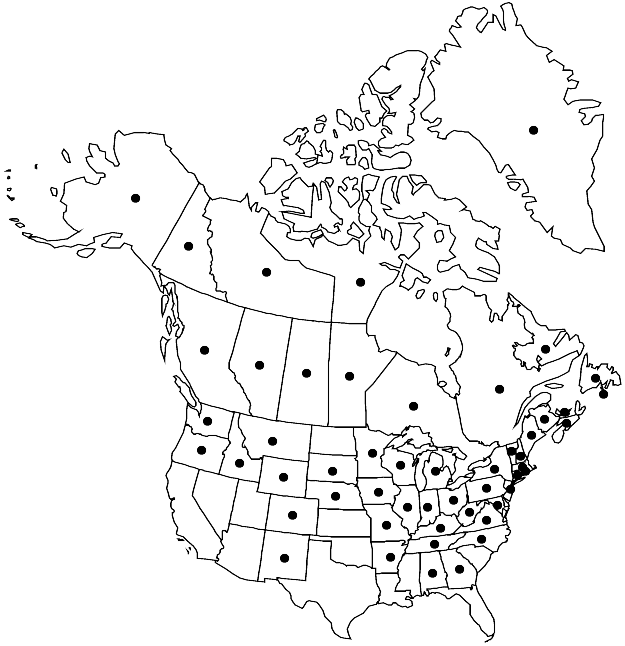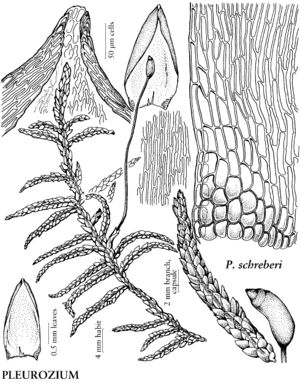Difference between revisions of "Pleurozium schreberi"
J. Linn. Soc., Bot. 12: 537. 1869.
FNA>Volume Importer |
imported>Volume Importer |
||
| (One intermediate revision by the same user not shown) | |||
| Line 70: | Line 70: | ||
|publication year=1869 | |publication year=1869 | ||
|special status=Illustrated | |special status=Illustrated | ||
| − | |source xml=https:// | + | |source xml=https://bitbucket.org/aafc-mbb/fna-data-curation/src/2e0870ddd59836b60bcf96646a41e87ea5a5943a/coarse_grained_fna_xml/V28/V28_521.xml |
|genus=Pleurozium | |genus=Pleurozium | ||
|species=Pleurozium schreberi | |species=Pleurozium schreberi | ||
Latest revision as of 21:36, 5 November 2020
Plants to 16 cm. Stems reddish, distinctly visible through wet leaves. Stem leaves moderately concave, 0.8–1.5 mm wide; apex often recurved; alar cells few, orange-brown, quadrate to oblong, slightly enlarged, 18–40 × 12–28 µm; medial laminal cells 50–100 × 6–9 µm; apical cells obviously shorter. Branch leaves concave, 0.8–1.9 × 0.3–0.8 mm. Seta 1.5–4.3 cm. Capsule ellipsoid, 1.5–2.5 mm.
Habitat: Soil, humus, rock, often covering forest floor in extensive mats, forest types from dry oak/pine/aspen to wet spruce muskeg, sometimes in bogs, fens, and grass balds, rarely in tundra
Elevation: low to high elevations (0-3000 m)
Distribution

Greenland, St. Pierre and Miquelon, Alta., B.C., Man., N.B., Nfld. and Labr., N.W.T., N.S., Nunavut, Ont., P.E.I., Que., Sask., Yukon, Ala., Alaska, Ark., Colo., Conn., Ga., Idaho, Ill., Ind., Iowa, Ky., Maine, Md., Mass., Mich., Minn., Mo., Mont., Nebr., N.H., N.J., N.Mex., N.Y., N.C., Ohio, Oreg., Pa., R.I., S.Dak., Tenn., Vt., Va., Wash., W.Va., Wis., Wyo., Mexico, Central America, South America, Eurasia, Africa, Atlantic Islands.
Discussion
Plants of Pleurozium schreberi are generally forest dwellers and rarely inhabit Arctic tundra. Arctic specimens often have long, slender, sparsely branched stems. An extreme example is the nomenclatural type of the var. tananae. In addition to the reduced branching and slender stems, its leaves are appressed-imbricate and somewhat smaller than the typical range for the species given in the description above. The distal leaf margins are slightly inrolled, so the apex appears obtuse to rounded rather than apiculate. Such specimens from Arctic tundra may be interpreted as rare forms of the species induced by the lower nutrient and harsher climatic conditions present outside of the normal forest habitat.
Selected References
None.
